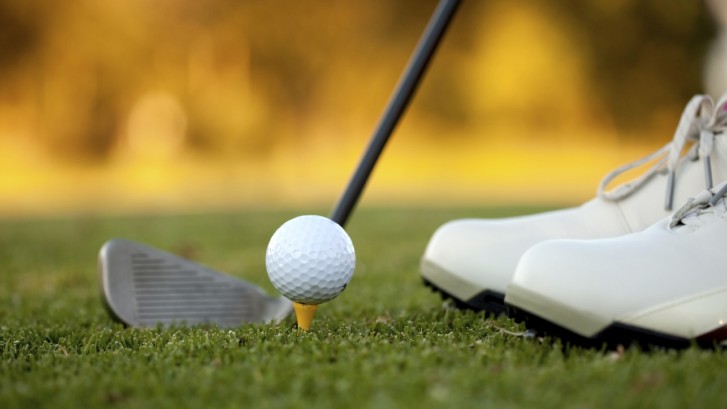 Is Foot Pain Ruining Your Golf Swing?
Is Foot Pain Ruining Your Golf Swing?
As you head to your favorite golf course this spring, make sure your feet are in shape before approaching the tee box. Your big toe, heel and ball of your foot are the spots most likely to cause pain that can ruin your golf swing.
Behind these pain-prone spots can lie stiff joints, stretched-out tissues and even nerve damage. But pain relief is possible and frequently does not require surgery.
Three conditions
The three most common foot conditions that can be the barrier to a perfect golf swing are neuromas, arthritis and heel pain.
- Neuromas are nerves that become thickened, enlarged and painful because they’ve been compressed or irritated. A neuroma in the ball of your foot can cause significant pain as your body transfers its weight from one foot to the other while swinging the club.
- Arthritis can cause pain in the joint of your big toe that makes it difficult to follow-through.
- Heel pain typically results from an inflammation of the band of tissue that extends from your heel to the ball of your foot. People with this condition compare the pain to someone jabbing a knife in their heel. Heel pain can make it uncomfortable for golfers to maintain a solid stance during crucial portions of the swing.
- Other painful conditions
Several other painful conditions can also make the perfect swing difficult. Ankle arthritis or ankle instability can affect the proper weight shift during the golf swing. Some athletes and former athletes develop chronic ankle instability from previous ankle sprains that failed to heal properly. Achilles tendonitis can also contribute to balance-threatening instability during your golf swing. Ill-fitting golf shoes may cause corns and calluses that make standing uncomfortable.
Foot pain is not normal. With the treatment options available to your foot and ankle surgeon, a pain-free golf swing is clearly in view. When your feet aren’t in top condition, your golf swing won’t be either.
That Pain in Your Back Could be Linked to Your Feet
 If your lower back has been hurting, and you don’t remember doing anything to injure it, the source of your pain could be your feet! Foot pain is something that many people try to ignore. After all, doesn’t everyone’s feet hurt now and then? But if foot pain is something that has been with you for quite awhile, it could be causing problems in your ankles, knees, hips and even your back.
If your lower back has been hurting, and you don’t remember doing anything to injure it, the source of your pain could be your feet! Foot pain is something that many people try to ignore. After all, doesn’t everyone’s feet hurt now and then? But if foot pain is something that has been with you for quite awhile, it could be causing problems in your ankles, knees, hips and even your back.
That old song, “The leg bone’s connected to the thigh bone…The thigh bone’s connected to the hip bone…,” tells the whole story. Our bodies are like a chain, with one link–or bone–connecting at the joint to another link. Think about what would happen if the first link in the chain was out of position. The point at which it meets the next link would eventually over stress that link and adversely affect the entire chain.
That’s what happens when we have foot pain. If the normal way of walking is painful, we instinctively change our walking pattern. Say you have arthritis, and your big toe joint hurts, so you change our gait to avoid bending the joint when you walk. Changing your gait changes the mechanics of your ankle joint, eventually causing ankle pain. This change in your walking pattern can also affect the whole chain of your lower body… from the ankle, to the knee, to the hip, and then to the lower back.
When foot pain or a foot deformity causes you to change the way you walk, it changes the way the bones of all those other joints move with each other. Cartilage in the joints can wear down, ligaments and tendons can be stressed beyond their normal range, and arthritis can set in.
If your feet or ankles aren’t working right, don’t ignore them! Contact a foot and ankle surgeon for an evaluation. Your back (and knees and hips) will thank you!
Leading the Way
First, your weight is placed lightly on the balls of your feet, balanced between your front and rear foot. Then there is a slight shift to the back foot, then another shift back to the front. Sound like dance steps? These intricate movements actually describe what goes on below the knees during an ordinary golf swing.
Good foot action is the mark of an accomplished golfer. “All timing, distance, and direction comes out of the lower body with the feet leading the way,” golf legend Jack Nicklaus has said. Nicklaus or any professional will tell you that problems with the feet, even a painful corn or callus, can impede timing and balance to the point where it’s reflected on the scorecard at the end of the day.
Close to 45 million Americans enjoy golf on an amateur level. Above and beyond the satisfaction of competition, a full round of golf affords the opportunity for a 4-5 mile workout that can reduce stress and improve cardiovascular health.
Be Prepared
Before taking to the links, your body needs to be prepared for the workout involved in walking the whole course. (If the pros can walk, so can you!) Anyone older than 40, or having any problems with weight, respiration, blood pressure, pulse rate, or cholesterol, should check with a doctor before playing. The same goes for smokers, diabetics, and people with preexisting injuries or a history of heart trouble.
Your podiatric physician, a foot and ankle specialist, knows the importance of wearing proper golf shoes. Once, driven by fashion, golf shoes were wing-tip oxfords with spikes. Today, shoes are constructed using basic principles of athletic footwear. Some even incorporate advanced technological innovations such as graphite shank reinforcements, which keep them light and add strength.
Don’t wear anything on your feet that wouldn’t be comfortable if you were taking a good long walk. Make sure shoes fit well in the store before purchasing them. It’s best to shop for them in the afternoon when the feet are slightly swollen. Try on shoes with the same socks you’ll wear on the course. Tie both left and right shoes tightly and walk around your store or pro shop a few minutes before deciding on a make and model.
Some simple stretching exercises are important before taking to the first tee and after leaving the last. Consult a podiatric physician who specializes in sports medicine for a light stretching regimen that will help alleviate stiffness after a day of golf.
The Ideal Swing
Biomechanics, the application of mechanical laws to living structures such as the feet, play a crucial part in developing the ideal golf swing. The lateral motion and the pivoting intrinsic to the golf swing can be functionally impeded by certain biomechanical conditions. Faulty biomechanics can inhibit proper foot function, and your game will suffer.
The anatomy of a biomechancially sound swing goes like this: During set-up, your weight should be evenly distributed on both feet with slightly more weight on the forefoot as you lean over, and slightly more weight on the insides of both feet.
Maintenance of proper foot alignment on the backswing is critical for control of the downswing and contact position. During the backswing, weight should be shifted to the back foot. It should be evenly distributed on the back foot or maintained slightly on the inside. Shifting weight to the outside leaves you susceptible to the dreaded “sway,” a common error in swing. Without an exact reversal of the sway in the downswing, swaying will result in improper contact with the ball.
As the back foot remains in a solid position on the back swing without any rolling to the outside, the front foot is in turn rolling to the inside. The front heel occasionally comes off the ground to promote a full shoulder turn. Completion of the backswing places the weight on the back foot, evenly distributed between forefoot and rearfoot, with the weight left on the front foot rolling to the inside.
The downswing involves a rapid shift of weight from back to front foot; momentum brings the heel of the front foot down, and follow-though naturally causes a rolling of the back foot to the inside and the front foot to the outside. Golf should always be played from the insides of the feet.
Like the great Nicklaus said, “lively feet” are critical to a successful golf game. Having healthy, biomechancially stable feet is the first prerequisite for achieving that goal.
Custom Orthotics: Preventing Pain, Improving Game
For the foot that is not able to function normally due to biomechanical conditions such as excessive pronation (rolling in) or supination (rolling out), a state of optimal biomechanics can be achieved through the use of custom orthotics, custom shoe inserts that can be prescribed by a podiatrist. Custom Orthotics not only allow the feet to function as they ought to but can alleviate the predisposition to injury brought on by biomechanical imbalances.
If you already wear custom orthotics in your street shoes, by all means transfer them to your golf shoes. Podiatrists who specialize in sports medicine say there are cases when orthotic devices optimally designed for golf shoes will be different than those designed for street shoes.
If biomechanical problems are present in your swing, they will invariably cause symptoms when walking the links as well. Addressing biomechanical problems in walking may therefore result in the secondary benefit of an improved swing through proper foot function.
If a round of golf is painful on the feet, first assess the quality of your shoes. Any time pain is not adequately resolved with good, stable golf shoes and is present for more than two or three consecutive rounds, it’s time to visit a podiatric sports physician. He or she can diagnose and treat any problems and help make your feet an asset, not a liability, to your golf game.
Other Injuries and Treatment
The torque of a golf swing can strain muscles in the legs, abdomen, and back. The fact that the game is usually played on hilly terrain increases these forces, which in turn predispose to injury. Proper warm-up and stretching exercises specific to golf can help in injury prevention. A sports podiatrist can recommend a suitable warm-up regimen.
If biomechanical imbalances are present, these existing stresses will overload certain structures, and predispose the golfer to overuse of muscles and strain on ligaments and tendons. Custom Orthotics will equalize the weight load on the lower extremity and in essence rest the overused muscle.
Other problems, such as tendinitis, capsulitis, and ligament sprains and pulls, can also keep a golf enthusiast back at the clubhouse. Improper shoes can bring on blisters, neuromas (inflamed nerve endings), and other pains in the feet. Podiatrists see these problems daily and can treat them conservatively to allow for a quick return to the sport.
When injured, participation is no substitute for rehabilitation. Injured body parts must be thoroughly treated and rehabilitated to meet the full demands of golf or any other sport. If you are injured, your return should be gradual. As much as you may want to get back to your game, take it slowly. A healthy body makes for a more enjoyable game and possibly a better scorecard at the end of the day.
Tips from the APMA
- Start easy and build up your playing time carefully
- Don’t forget to stretch regularly
- Fit your shoes with the socks that you plan to wear.


